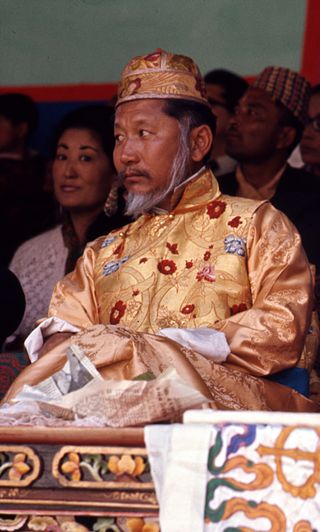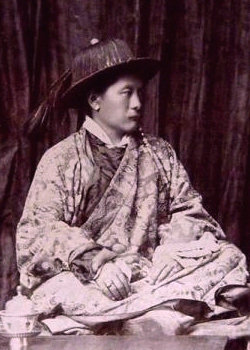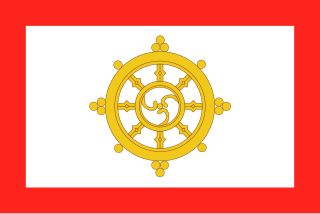
Palden Thondup Namgyal was the 12th and last Chogyal (king) of the Kingdom of Sikkim.

Tashi Namgyal was the ruling Chogyal (King) of Sikkim from 1914 to 1963. He was the son of Thutob Namgyal. He was the first independent king of Sikkim.

Hope Cooke was the Gyalmo of the 12th Chogyal (King) of Sikkim, Palden Thondup Namgyal. Their wedding took place in March 1963. She was termed Her Highness The Crown Princess of Sikkim and became the Gyalmo of Sikkim at Palden Thondup Namgyal's coronation in 1965.

The Chogyal were the monarchs of the former Kingdom of Sikkim, which belonged to the Namgyal dynasty. The Chogyal was the absolute monarch of Sikkim from 1642 to 1973, and the constitutional monarch from 1973 to 1975, when the monarchy was abolished and the Sikkimese people voted in a referendum to make Sikkim the 22nd state of India.

The history of Sikkim begins with the indigenous Lepcha's contact with early Tibetan settlers. Historically, Sikkim was a sovereign Monarchical State in the eastern Himalayas. Later a protectorate of India followed by a merger with India and official recognition as a state of India. Lepchas were the main inhabitants as well as the Ruler of the land up to 1641. Lepchas are generally considered to be the first people, indigenous to Sikkim also includes Darjeeling.

Yuksom is a historical town, just 40 km Gyalshing city in the Gyalshing district in the Northeast Indian state of Sikkim. It was the first capital of Kingdom of Sikkim established in 1642 AD by Phuntsog Namgyal who was the first Chogyal of Sikkim. The coronation site of the first monarch of Sikkim is known as the "Throne of Norbugang". Yuksom is where there is the Norbugang Chorten near the Norbugang throne, the place Namgyal was crowned and several monasteries and a lake. The dynastic rule of the Chogyal lasted for 333 years.

Phuntsog Namgyal (1604–1670) was the first Chogyal (monarch) of Sikkim, now an Indian state. He consecrated in 1642 at the age of 38. Phuntsog was a fifth generation descendant of Khye Bumsa, a 13th-century prince from the Mi-nyak House in Kham in Eastern Tibet. According to legend, Guru Rinpoche, a 9th-century Buddhist saint had foretold the event that a Phuntsog from the east would be the next chogyal of Sikkim. In 1642, three lamas, from the north, west, and south went in search for the chosen person. Near present-day Gangtok, they found a man churning milk. He offered them some refreshments and gave them shelter. So impressed were they by his deeds that they realised that he was a chosen one and immediately crowned him king. The crowning took place Norbughang near Yuksom on a stone slab in a pine covered hill, and he was anointed by sprinkling water from a sacred urn.
Tensung Namgyal (1644–1700) was the second Chogyal (monarch) of Sikkim. He succeeded his father Phuntsog Namgyal in 1670 and moved the capital from Yuksom to Rabdentse near Geyzing. He had three wives from Bhutan, Nambi Onmo, Tibet, Lhacham Pema Putik, and a Limbu princess from the Arun valley, Thungwamukma. After establishing Rabdentse as his new capital he built a palace and asked his Limbu Queen to name it. She named it "Song Khim" which in Limbu language means "New Palace". This later went on to become "Sukhim" and "Sikkim". He was succeeded by his son Chakdor Namgyal, borne by his second wife in 1700. He had one last son with his third wife. Though he is not well known his grandson becomes a king of a small kingdom inside his father's rule.

Tashi Namgyal Academy (TNA) is a public school in the Himalayan state of Sikkim in India. It was founded in 1926 by the late Sir Tashi Namgyal, KCSI, KCIE, the 11th consecrated Ruler of Sikkim. It is an autonomous English-medium, co-educational and residential-cum-day school.

Thutob Namgyal was the ruling chogyal (monarch) of Sikkim between 1874 and 1914. Thutob ascended to the throne succeeding his half-brother Sidkeong Namgyal who died issueless. Differences between the Nepalese settlers and the indigenous population during his reign led to the direct intervention of the British, who were the de facto rulers of the Himalayan nation. The British ruled in favour of the Nepalese much to the discontent of the chogyal, who then retreated to the Chumbi Valley and allied himself with the Tibetans.
Tsugphud Namgyal (1785–1863) was king of Sikkim from 1793 to 1863. He gained independence from Nepal in 1815 and ruled under a British protectorate from 1861.

The Kingdom of Sikkim, officially Dremoshong until the 1800s, was a hereditary monarchy in the Eastern Himalayas which existed from 1642 to 16 May 1975, when it was annexed by India. It was ruled by Chogyals of the Namgyal dynasty.
The indigenous people of Sikkim are the Lepchas; the naturalized ethnic populations of Limbus, Bhutias, Kiratis, & Indian Gorkha of Nepalese descendants who have an enduring presence in shaping the history of modern Sikkim. The indigeneity criteria for including all peoples of Sikkim and Darjeeling hills is a misnomer as it is clearly known that Lepchas are the first people who trace their origin and culture of their ethnogenesis to the historical and somewhat political geography of Sikkim history as is well documented by colonial and immigrant settler history. However many tribes preceded the migration of the colonial powers and can trace their migratory background as well as ancestral heritage and a well formed history of civilization and cultural locus that is not inherently indigenous to Sikkim.

Phodong Monastery is a Buddhist monastery in Sikkim, India. It is located 28 kilometres from Gangtok. It was built in the early 18th century but an older monastery had pre-existed the current one.
Phuntsog Namgyal II was the fifth Chogyal (king) of Sikkim. He succeeded Gyurmed Namgyal in 1733 and was succeeded himself by Tenzing Namgyal in 1780.
A referendum on abolishing the monarchy was held in the Kingdom of Sikkim on 14 April 1975. Official results stated the proposal was approved by 97.55% of voters with a turnout of about 63%, and resulted in the country becoming an Indian state.
Bhim Bahadur Gurung was the third Chief Minister of Sikkim. He held office from 11 May until 24 May 1984, the shortest term in the history of Sikkim.

Alice S. Kandell is an American child psychologist, author, photographer and art collector interested in Himalayan culture. She worked extensively in the Indian state of Sikkim as a photographer, capturing approximately 15,000 color slides, as well as black-and-white photographs, between 1965 and 1979.

The State Council of Sikkim was the unicameral legislature of the former Kingdom of Sikkim, which was located in the Himalayas, between India and China.

Jahan Bagcha Teesta Rangeet is a song that serves as the de facto state song for Sikkim, India.













